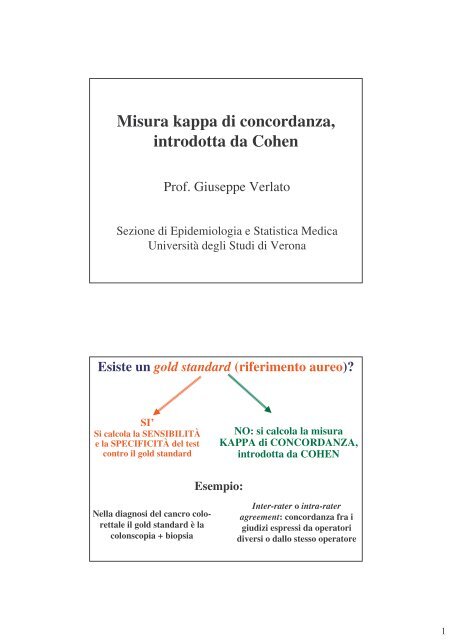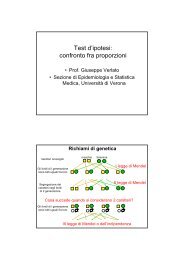Misura kappa di concordanza, introdotta da Cohen - Sezione di ...
Misura kappa di concordanza, introdotta da Cohen - Sezione di ...
Misura kappa di concordanza, introdotta da Cohen - Sezione di ...
Create successful ePaper yourself
Turn your PDF publications into a flip-book with our unique Google optimized e-Paper software.
<strong>Misura</strong> <strong>kappa</strong> <strong>di</strong> <strong>concor<strong>da</strong>nza</strong>,<br />
<strong>introdotta</strong> <strong>da</strong> <strong>Cohen</strong><br />
Prof. Giuseppe Verlato<br />
<strong>Sezione</strong> <strong>di</strong> Epidemiologia e Statistica Me<strong>di</strong>ca<br />
Università degli Stu<strong>di</strong> <strong>di</strong> Verona<br />
Esiste un gold stan<strong>da</strong>rd (riferimento aureo)?<br />
SI’<br />
Si calcola la SENSIBILITÀ<br />
e la SPECIFICITÀ del test<br />
contro il gold stan<strong>da</strong>rd<br />
Nella <strong>di</strong>agnosi del cancro colorettale<br />
il gold stan<strong>da</strong>rd è la<br />
colonscopia + biopsia<br />
NO: si calcola la misura<br />
KAPPA <strong>di</strong> CONCORDANZA,<br />
<strong>introdotta</strong> <strong>da</strong> COHEN<br />
Esempio:<br />
Inter-rater o intra-rater<br />
agreement: <strong>concor<strong>da</strong>nza</strong> fra i<br />
giu<strong>di</strong>zi espressi <strong>da</strong> operatori<br />
<strong>di</strong>versi o <strong>da</strong>llo stesso operatore<br />
1
Stu<strong>di</strong>o sulla <strong>di</strong>scinesia tar<strong>di</strong>va<br />
giu<strong>di</strong>ce<br />
a<br />
χ 2 = 88.23<br />
giu<strong>di</strong>ce b<br />
presente assente totale<br />
pres. 123 10 133<br />
ass. 6 29 35<br />
totale 129 39 168<br />
P < 0.0000001<br />
Bergen et al (1992) Stu<strong>di</strong>o sulla <strong>di</strong>scinesia tar<strong>di</strong>va.<br />
Il chi-quadrato ci dà scarse informazioni.<br />
Abbiamo semplicemente falsificato<br />
l’ipotesi nulla che le <strong>di</strong>agnosi del primo<br />
clinico fossero del tutto in<strong>di</strong>pendenti <strong>da</strong>lle<br />
<strong>di</strong>agnosi del secondo clinico.<br />
Tuttavia questo risultato può essere<br />
conseguito anche <strong>da</strong> due clinici molto<br />
MEDIOCRI.<br />
2
<strong>Misura</strong> <strong>di</strong> <strong>concor<strong>da</strong>nza</strong> osservata<br />
(Proportion of agreement)<br />
giu<strong>di</strong>ce<br />
a<br />
giu<strong>di</strong>ce b<br />
presente assente totale<br />
pres. a b a+b<br />
ass. c d c+d<br />
totale a+c b+d N<br />
a + d<br />
P0 = ———<br />
N<br />
<strong>Misura</strong> <strong>di</strong> <strong>concor<strong>da</strong>nza</strong> osservata<br />
(Proportion of agreement)<br />
giu<strong>di</strong>ce<br />
a<br />
giu<strong>di</strong>ce b<br />
presente assente totale<br />
pres. 123 10 133<br />
ass. 6 29 35<br />
totale 129 39 168<br />
P0 = ————<br />
123 +29<br />
= ——<br />
152<br />
= 0.905<br />
168 168<br />
Bergen et al (1992) Stu<strong>di</strong>o sulla <strong>di</strong>scinesia tar<strong>di</strong>va.<br />
3
Però anche due persone completamente<br />
ignoranti <strong>di</strong> me<strong>di</strong>cina riescono a raggiungere<br />
una certa <strong>concor<strong>da</strong>nza</strong>, per semplice effetto<br />
del caso.<br />
A noi interessa valutare <strong>di</strong> quanto la<br />
<strong>concor<strong>da</strong>nza</strong> fra gli esperti eccede la<br />
<strong>concor<strong>da</strong>nza</strong> attesa per semplice effetto del<br />
caso.<br />
Concor<strong>da</strong>nza ATTESA<br />
per effetto del caso<br />
(agreement expected just by chance)<br />
aexp + dexp Pexp = ————<br />
N<br />
Sotto l’ipotesi <strong>di</strong> in<strong>di</strong>pendenza statistica<br />
atteso = (totale riga) * (totale colonna) / (totale generale)<br />
4
giu<strong>di</strong>ce<br />
a<br />
giu<strong>di</strong>ce b<br />
presente assente totale<br />
pres. a b a+b<br />
ass. c d c+d<br />
totale a+c b+d N<br />
(a+b) * (a+c)<br />
aexp = ——————<br />
N<br />
giu<strong>di</strong>ce<br />
a<br />
Concor<strong>da</strong>nza attesa<br />
giu<strong>di</strong>ce b<br />
presente assente totale<br />
pres. 123 10 133<br />
ass. 6 29 35<br />
totale 129 39 168<br />
a atteso = (133 * 129) / 168 = 102.125<br />
d atteso = (35*39) / 168 = 8.125<br />
Pe =<br />
102.1+8.1<br />
———— =<br />
110.25<br />
——— = 0.656<br />
168 168<br />
5
1,0<br />
0,8<br />
0,6<br />
0,4<br />
0,2<br />
0,0<br />
1,0<br />
0,8<br />
0,6<br />
0,4<br />
0,2<br />
0,0<br />
Concor<strong>da</strong>nza<br />
globale<br />
P obs - P exp =<br />
0.905 - 0.656 =<br />
= 0.249<br />
0.905<br />
0.656<br />
Concor<strong>da</strong>nza<br />
attesa per caso<br />
1 - P exp =<br />
1 - 0.656 = 0.344<br />
K = -------------- = --------- = 0.724<br />
P obs - P exp 0.249<br />
1 - P exp 0.344<br />
6
1,0<br />
0,8<br />
0,6<br />
0,4<br />
0,2<br />
0,0<br />
strength of agreement<br />
k= 0.81 - 1.00 very good<br />
k= 0.61 - 0.80 good<br />
k= 0.41 - 0.60 moderate<br />
k= 0.21 - 0.40 fair<br />
k =< 0.20 poor<br />
Altman DG (1991) Practical statistics for me<strong>di</strong>cal research. Chapman & Hall: London.<br />
A parità <strong>di</strong> <strong>concor<strong>da</strong>nza</strong>, la misura k è massima quando la<br />
prevalenza dei positivi (malati) è prossima a 0.50.<br />
giu<strong>di</strong>ce b<br />
giu<strong>di</strong>ce<br />
a<br />
giu<strong>di</strong>ce<br />
a<br />
presente assente totale<br />
pres. 70 10 80<br />
ass. 10 10 20<br />
totale 80 20 100<br />
giu<strong>di</strong>ce b<br />
presente assente totale<br />
pres. 40 10 50<br />
ass. 10 40 50<br />
totale 50 50 100<br />
P obs = 80 / 100 = 0.80<br />
a exp = (80*80) / 100 = 64<br />
d exp = (20*20) / 100 = 4<br />
P exp = (64+4) / 100 = 0.68<br />
k= (0.80-0.68)/(1-0.68) =0.38<br />
P obs = 80 / 100 = 0.80<br />
a exp = (50*50) / 100 = 25<br />
d exp = (50*50) / 100 = 25<br />
P exp = (25+25) / 100 = 0.50<br />
k= (0.80-0.50)/(1-0.50) =0.60<br />
7
E’ possibile stu<strong>di</strong>are separatamente la <strong>concor<strong>da</strong>nza</strong><br />
fra le risposte positive e le risposte negative,<br />
attraverso gli in<strong>di</strong>ci:<br />
First<br />
survey<br />
First<br />
survey<br />
P pos = proportion of positive agreement<br />
P neg = proportion of negative agreement<br />
Proportion of negative agreement<br />
2 nd survey<br />
No Yes Total<br />
No a b a+b<br />
Yes c d c+d<br />
Total a+c b+d N<br />
Pneg =————<br />
a<br />
(a+b+a+c)/2<br />
Proportion of positive agreement<br />
2<br />
Ppos =————<br />
d<br />
(b+d+c+d)/2<br />
nd survey<br />
No Yes Total<br />
No a b a+b<br />
Yes c d c+d<br />
Total a+c b+d N Cicchetti & Feinstein, J Clin Epidemiol, 1990<br />
8




